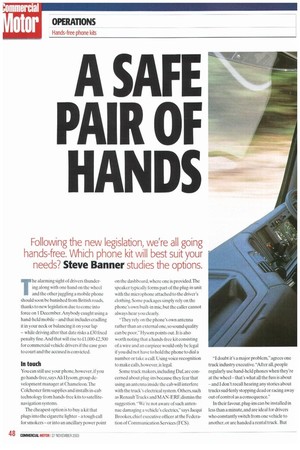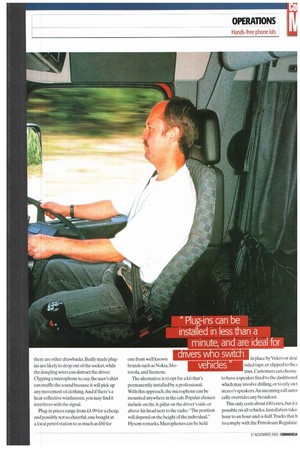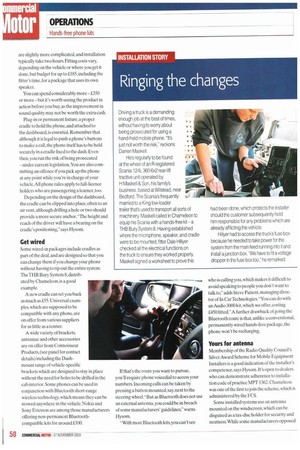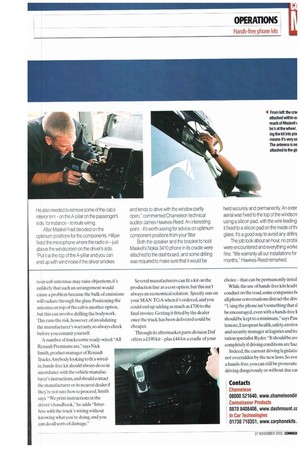A SAFE
Page 50

Page 51

Page 52

Page 53

If you've noticed an error in this article please click here to report it so we can fix it.
PAIR OF
HANDS
Following the new legislation, we're all going hands-free. Which phone kit will best suit your
needs? Steve Banner studies the options.
The alarming sight of drivers thundering along with one hand on the wheel and the otherjuggfing a mobile phone should soon be banished from British roads, thanks to new legislation due to come into force on 1 December. Anybody caught using a hand-held mobile —and that includes cradling it in your neck or balancing it on your lap — while driving after that date risks a i30 fixed penalty fine. And that will rise to .£1,000-12,500 for commercial vehicle drivers if the case goes to court and the accused is convicted.
In touch
'toucan still use your phone, however, if you go hands-free,saysAli Hysom, group development manager at Chameleon.The Colchester firm supplies and installs in-cab technology from hands-free kits to satellitenavigation systems.
The cheapest option is to buy a kit that plugs into the cigarette lighter — a tough call for smokers—or into an ancillary power point on the dashboard, where one is provided.The speaker typically forms part of the plug-in unit with the microphone attached to the driver's clothing. Some pack ages simply rely on the phone's own built-in mic, but the caller cannot always hear you clearly.
"They rely on the phone's own antenna rather than an external one, so sound quality can be poor," H ysorn points out. It is also worth noting that a hands-free kit consisting of a wire and an earpiece would only be legal if you did not have to hold the phone to dial a number or take a call. Using voice recognition to make calls, however, is legal.
Some truck makers, including Daf, are concerned about plug-ins because they fear that using an antenna inside the cab will interfere with the truck's electrical system. Others, such as Renault Trucks and MAN-ERE dismiss the suggestion." We're not aware of such antennae damaging a vehicle's electrics," says Jacqui Brookes,chief executive officer at the Federation of Communication Services (FCS). "I doubt it's a major problem," agrees one truck industry executive. "Alter all,people regularly use. hand-held phones when they're at the wheel — that's what all the fuss is about — and! don't recall hearing any stories about trucks suddenly stopping dead or racing away out of control as a consequence."
In their favour, plug-ins can be installed in less than a tninute,and are ideal for drivers who constantly switch from one vehicle to another,or are handed a rental truck. But there are other drawbacks. Badly made plugins are likely to drop out of the socket, while the dangling wires can distract the driver. Clipping a microphone to, say, the user's shirt can muffle the sound because it will pick up any movement of clothing.And if there's a heat-reflective windscreen, you may find it interferes with the signal.
Plug-in prices range from £4.99 for a cheap, and possibly not so cheerful, one bought at a local petrol station to as much as £60 for one from well known brands such as Nokia. Motorola, and Siemens.
The alternative is to opt for a kit that's permanently installed by a professional. With this approach, the microphone can be mounted anywhere in the cab. Popular choices include on the A pillar on the driver's side, or above his head next to the radio. "The position will depend on the height of the individual," Hysom remarks. Microphones can be held in place by Velcro or doul sided tape,or clipped to the trim. Customers can choose to have a speaker fixed to the dashboard which may involve drilling, or to rely on t stereo's speakers. An incoming call auto: cally overrides any broadcast.
This only costs about £40 extra, but it i: possible on all vehicles. Installation take: hour to an hour-and-a-halfTrucks that h to comply with the Petroleum Regulatic are slightly more complicated, and installation typically take two hours. Fitting costs vary, depending on the vehicle or where you get it done, but budget for up to £185, including the fitter's time, for a package that uses its own speaker.
You can spend considerably more -£350 or more but it's worth seeing the product in action before you buy, as the improvement in sound quality may not be worth the extra cash.
Plug-in or permanent fixture, a proper cradle to hold the phone.and attached to the dashboard, is essential. Remember that although it is legal to push a phone's buttons to make a call,the phone itself has to be held securely in a cradle fixed to the dash. Even then. you run the risk of being prosecuted under current legislation. You are also committing an offence if you pick up the phone at any point while you're in charge of your vehicle. All phone rules apply to full-licence holders who are passengering a learner. too.
Depending on the design of the dashboard, the cradle can be clipped into place, often to an air vent,although drilling a hole or two should provide a more secure anchor. "The height and reach of the driver will have a bearing on the cradle's positioning," says Hysom.
Get wired
Some wired-in packages include cradles as part of the deal, and are designed so that you can change them if you change your phone without having to rip out the entire system. The THB Bury System 8, distributed by Chameleon,is a good example.
A new cradle can set you back as much as £55. Universal examples, which are supposed to be compatible with any phone, are on offer from various suppliers for as little as a tenner.
A wide variety of brackets, antennae and other accessories are on offer from Connoisseur Products,(see panel for contact details) including the Dashmount range of vehicle-specific brackets which are designed to stay in place without the need for holes to be drilled in the cab interior. Some phones can be used in conjunction with Bluetooth short-range wireless technology, which means they can be stowed anywhere in the vehicle, Nokia and Sony Ericsson are among those manufacturers offering non-permanent Bluetoothcompatible kits for around £100. If that's the route you want to pursue, you'll require phone voicedial to access your numbers. Incoming calls can be taken by pressing a button mounted, say, next to the steering wheel. "But as Bluetooth does not use an external antenna, you could be in breach of some manufacturers' guidelines," warns Hysom.
"With most Bluetooth kits, you can't see who is calling you, which makes it difficult to avoid speaking to people you don't want to talk to," adds Steve Patient, managing director of In Car Technologies."You can do with an Audio 3000 kit, which we offer, costing £450 fitted "A further drawback of going the Bluetooth route is that, unlike a conventional, permanently wired hands-free package, the phone won't be recharging.
Yours for antenna
Membership of the Radio Quality Council's Silver Award Scheme for Mobile Equipment Installers is a good indication of the installer's competence,says Hysom. It's open to dealers who can demonstrate adherence to installation code of practice MPT 1362. Chameleon was one of the first to join the scheme, which is administered by the FCS.
Some installed systems use an antenna mounted on the windscreen, which can be disguised as a tax-disc holder for security and neatness.While some manufacturers opposed to in-cab antennae may raise objections, it's unlikely that such an arrangement would cause a problem because the bulk of emissions will radiate through the glass. Positioning the antenna on top of the cab is another option, but this can involve drilling the bodywork. This runs the risk, however, of invalidating the manufacturer's warranty, so always check before you commit yourself.
A number of trucks come ready-wired."All Renault Premiums are," says Nick Smith, product manager of Renault Trucks.Anybody looking to fit a wiredin. hands-free kit should always do so in accordance with the vehicle manufacturer's instructions, and should contact the manufacturer or its nearest dealer if they're not sure how to proceed. Smith says. "We print instructions in the driver's handbook," he adds."Interfere with the truck's wiring without knowing what you're doing, and you can do all sorts of damage." Several manufacturers can fit a kit on the production line as a cost option,but this isn't always an economical solution. Specify one on your MAN TGA when it's ordered, and you could end up adding as much as £700 to the final invoice. Getting it fitted by the dealer once the truck has been delivered could be cheaper.
Through its aftermarket parts division Daf offers a £198 kit -plus £44 for a cradle of your choice that can be permanently instal While the use of hands-free kits lead t conduct on the road,some companies bi all phone conversations distract the driv "Using the phone isn't something that sl be encouraged, even with a hands-free k should be kept to a minimum," says Pau lemore,European health,safety,enviroi and security manager at logistics and tra tation specialist Ryder."It should be aw completely if driving conditions arc haz Indeed, the current driving legislatio not overridden by the new laws. So eve a hands-free, you can still be prosecute driving dangerously or without due cal


























































































































































































